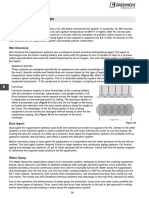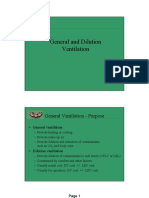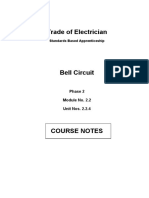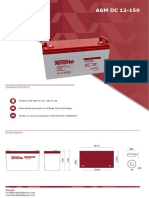At a glance
Powered by AI
The key takeaways are the code requirements for battery room ventilation to prevent hydrogen gas concentrations and the different ventilation system designs discussed.
8/15/2019 Digital Renditiondigital.bnpmedia.com/publication/?i=494131&article_id=3078794&view=articleBrowser#{"issue_id":494131,"view":"articleBrowser","article_id":"307879… 1/7
Designing Ventilation For Battery Rooms
Jose Osmin Pineda, P.E.
There is no shortage of codes and guidance to consider when engineering for thisenvironment, but with a truly explosive worst-case scenario, it’s worth every effort to ensuresafe hydrogen management.Battery rooms or stationary storage battery systems (SSBS) have code requirements such asfire-rated enclosure, operation and maintenance safety requirements, and ventilation toprevent hydrogen gas concentrations from reaching 4% of the lower explosive level (LEL).Code and regulations require that LEL concentration of hydrogen (H2) be limited to 25% of LELor 1% of room volume. The room ventilation method can be either forced or natural andeither air-conditioned or unconditioned. Battery manufacturers require that batteries bemaintained at 77ºF for optimum performance and warranty. This article will look into thebattery room ventilation requirements, enclosure configurations, and the different ways toaccomplish them.BACKGROUNDTypical applications of SSBS are as backup power in uninterruptible power supply (UPS)systems for telecommunication rooms, electrical substations controls, and data centers. SSBSprovide temporary power during momentary power failure while the main backup power,typically diesel or propane generators, synchronize with the power demand.Typical battery SSBS are composed of batteries of the flooded lead-acid batteries, ValveRegulated Lead-Acid (VRLA), or nickel- Cadmium (Ni-Cd) batteries, a battery charger, rectifiers,inverters, converters, and associated electrical equipment. The SSBS are normally housed in aroom as a part of a main building or as a standalone enclosure. During the charging anddischarging of the batteries, H2 gas is released, which can be explosive and catastrophic atlevels between 4% of LEL and 74% of the HEL.The applicable codes and regulations for designs, safety operation, and maintenance of battery rooms are the Building Code, Mechanical Code, Fire Code, National Electrical Code(NEC), Occupational Safety and Health Administration (OSHA), and the Institute of Electricaland Electronics Engineers (IEEE) Standards.CODES AND REGULATIONSThe following summarizes codes and requirements for ventilation at the national level. Stateand local jurisdictions may have more stringent ventilation requirements. For example, the
8/15/2019 Digital Renditiondigital.bnpmedia.com/publication/?i=494131&article_id=3078794&view=articleBrowser#{"issue_id":494131,"view":"articleBrowser","article_id":"307879… 2/7
California Code of Regulations or CAL-OSHA, requires H2 gas concentration to not exceed 20%of LEL or 0.8% of the room volume, compared to 25% of LEL or 1% of the room volume in thenational level. Check with your local jurisdiction for specific ventilation requirements.Mechanical CodeThe International Mechanical Code (IMC) specifies similar requirements as NFPA 1 andInternational Fire Code. The Uniform Mechanical Code (UMC) does not directly address batteryroom ventilation but specifies that if a proposed occupancy is not listed in Table 4-4, therequirements for the listed occupancy that is most similar to the proposed space in term of occupant density and occupancy type shall be used. The occupancy that resembles that of abattery room on Table 4-4 is a science lab classroom where flammable or explosive gases maybe present. The ventilation rate required is 1.0 cfm/sq-ft.These codes have additional requirements that specify the design, construction, andinstallation of the ventilation system.International Fire CodeThe International Fire Code (IFC) requirements are such that when the battery storage systemcontains more than 50 gallons of electrolyte for flooded lead-acid, nickel cadmium (Ni-Cd), andvalve regulated lead-acid (VRLA) or more than 1,000 pounds for lithium-ion batteries, theventilation requirements are as follows:1.For flooded lead acid, flooded Ni-Cd, and VRLA batteries, the ventilation system shall bedesign to limit the maximum concentration of hydrogen to 1% of the total volume of theroom; or2.Continuous ventilation shall be provided at a rate of not less than 1 cubic foot per second of the floor area of the room.3.Mechanical ventilation system shall be supervised by an approved central, proprietary, orremote station service, or shall initiate an audible and visual signal at a constant attended on-site location.NFPA 1 — Fire Code, has similar ventilation requirements as IFC, with the exception of electrolyte quantity. NFPA 1 ventilation requirements apply to stationary storage batterysystems having more than 100 gallons of electrolyte in sprinklered buildings and more than 50gal of electrolyte in unsprinklered.National Electrical Code (NEC)Article 480.9(A) of the NEC states that provisions appropriate to the battery technology shall bemade for sufficient diffusion and ventilation of the gases from the battery, if present, toprevent accumulation of an explosive mixture.Adequate ventilation is required to prevent classification of a battery location as a hazardous(classified) location in accordance with Article 500.Occupational Safety and Health Administration (OSHA)
8/15/2019 Digital Renditiondigital.bnpmedia.com/publication/?i=494131&article_id=3078794&view=articleBrowser#{"issue_id":494131,"view":"articleBrowser","article_id":"307879… 3/7
Title 29 Code of Federal Regulations — Ventilation shall be provided to ensure diffusion of thegases from battery and to prevent accumulation of an explosive mixture.The Institute of Electrical and Electronics Engineers (IEEE) Standards 1188, 450, 484, and 485provide guides that focus on the battery system design, maintenance, and operation. All thesecodes and regulations require ventilation or some type of provision to prevent H2 gasaccumulation to LEL level.DESIGN CONSIDERATIONSApplying Most Stringent Codes and RegulationsConsidering the most stringent requirements from the different codes, the following codesapply: OSHA, NFPA 1, IFC, and UMC or IMC. Also, it is worth noting that by providing adequateventilation at 1 cfm/sq-ft, the NEC Article 480.9(A) requirement is met and the battery roomneed not be classified as a Hazardous location, Class I, Division 1, Group B, per NEC Article500.The codes allow for natural or mechanical ventilation. However, only mechanical ventilationsystems will be discussed due to the unreliability of natural ventilation. The two code-requiredapproaches to satisfy the ventilation requirements are to continuously ventilate the space at 1cfm/sq-ft or intermittently ventilate the enclosure as needed by monitoring and limiting H2concentration to not exceed 25% of LEL.Continuous VentilationOf the two code requirements, continuous ventilation at 1 cfm/ sq-ft is the easier approachsince no calculation is needed for the H2 evolution rate. However, this option may beimpractical when the space is air conditioned, because exhausting conditioned air is a waste of energy and the 77ºF room temperature normally required by the battery manufacturer will behard to maintain in high ambient temperature applications — a decision the owner mustconsider in order maintain to batteries warranty.The continuous ventilation system must be monitored for airflow and can be done byinstalling a f low switch upstream or downstream of the exhaust fan at locations withminimum air turbulence and stable static pressure readings. Flow switches are available withForm C relays and can be used to send local or remote signals to notify maintenancepersonnel if the exhaust fan is not operating.The downside of continuous ventilation is that it increases maintenance and energy costs, andreduces the service life of the fan. An estimated cost of approximately $200/yr of energywould be wasted at rate of $2/cfm, assuming 100-cfm exhaust fan. Therefore, continuousventilation is recommended only when the space is not air conditioned.An alternative variation of continuous ventilation in air conditioned battery room spaces is toutilize, as makeup air, the conditioned air from other occupied spaces that would requireventilation as part of the indoor air quality requirements.Intermittent Ventilation, Monitoring, and Limiting H2 Concentration
8/15/2019 Digital Renditiondigital.bnpmedia.com/publication/?i=494131&article_id=3078794&view=articleBrowser#{"issue_id":494131,"view":"articleBrowser","article_id":"307879… 4/7
The second of the two code-required ventilating systems is the intermittent ventilationcoupled with H2 monitoring and limiting. This approach requires the design of a gas detectionand ventilation system that will operate only when it is needed. The ventilation systemrequires the calculation of H2 evolution rate generated by the battery systems. This H2evolution rate is crucial to properly sizing the exhaust fan. When calculating the H2 evolutionrate, the following factors need to be considered: types of batteries used (VRLA, flooded lead-acid, or Ni-Cd), charging mode (float or boost mode), battery system charging current andvoltage, and the quantity of batteries. The H2 evolution rate can be calculated using IEEE1635/ASHRAE Guideline 21 — Guide for the Ventilation and Thermal Management of Batteriesfor Stationary Applications formulas. However, it is best to obtain the H2 evolution ratedirectly from the battery manufacturer since the battery chemistry varies between batterymanufacturers.The gas detection system monitors and limits the H2 concentration from exceeding the 25% of LEL level in the space, and it interlocks with the exhaust fan to operate when H2 is detected.The gas detection system is composed of a H2 sensor head, communication wiring, and a H2controller. The sensor monitors the hydrogen levels and when the predeterminedconcentration is reached, sends a signal to the H2 controller to activate the proper alarms. TheH2 controller is recommended to be installed on the outside of the enclosure if possible so H2concentration levels can be verified before entering the space.Most H2 controllers come configured with two alarms. Alarm one normally energizes theexhaust fan and motorized make-up air dampers to open. Alarm two reports normally to aremote occupied location to notify personnel and can be designed to activate local horns andstrobes. Alarm two satisfies the monitoring requirement since it will notify personnel when theexhaust fan does not operate.The battery system layout and ceiling construction will determine the best location for the gassensors. Follow manufacturer’s installation guidelines for H2 sensor location and sensorcoverage area. H2 is lighter than air and rises to ceiling areas; therefore, the ceiling must besmooth to avoid pockets that can trap H2 gas. The detection system requires regularmaintenance and cost can be minimal if scheduled at the same time the battery system ischecked.BATTERY ROOM CONFIGURATIONSThe suitability of the ventilation approach can be influenced by the configuration of thebattery room. The battery system may be installed in a dedicated enclosure or within a spacethat is shared with other office spaces, or in areas much larger than the battery room like in awarehouse.Dedicated EnclosureFor battery rooms with a dedicated enclosure that are not air conditioned and are relativelysmall, continuous ventilation at 1 cfm/sq-ft is a simple and practical design. The exhaust fancan be ceiling or wall-mounted. Wall-mounted exhaust fans must be installed as close aspossible to the ceiling, providing enough clearance for service and maintenance between fan



































































































